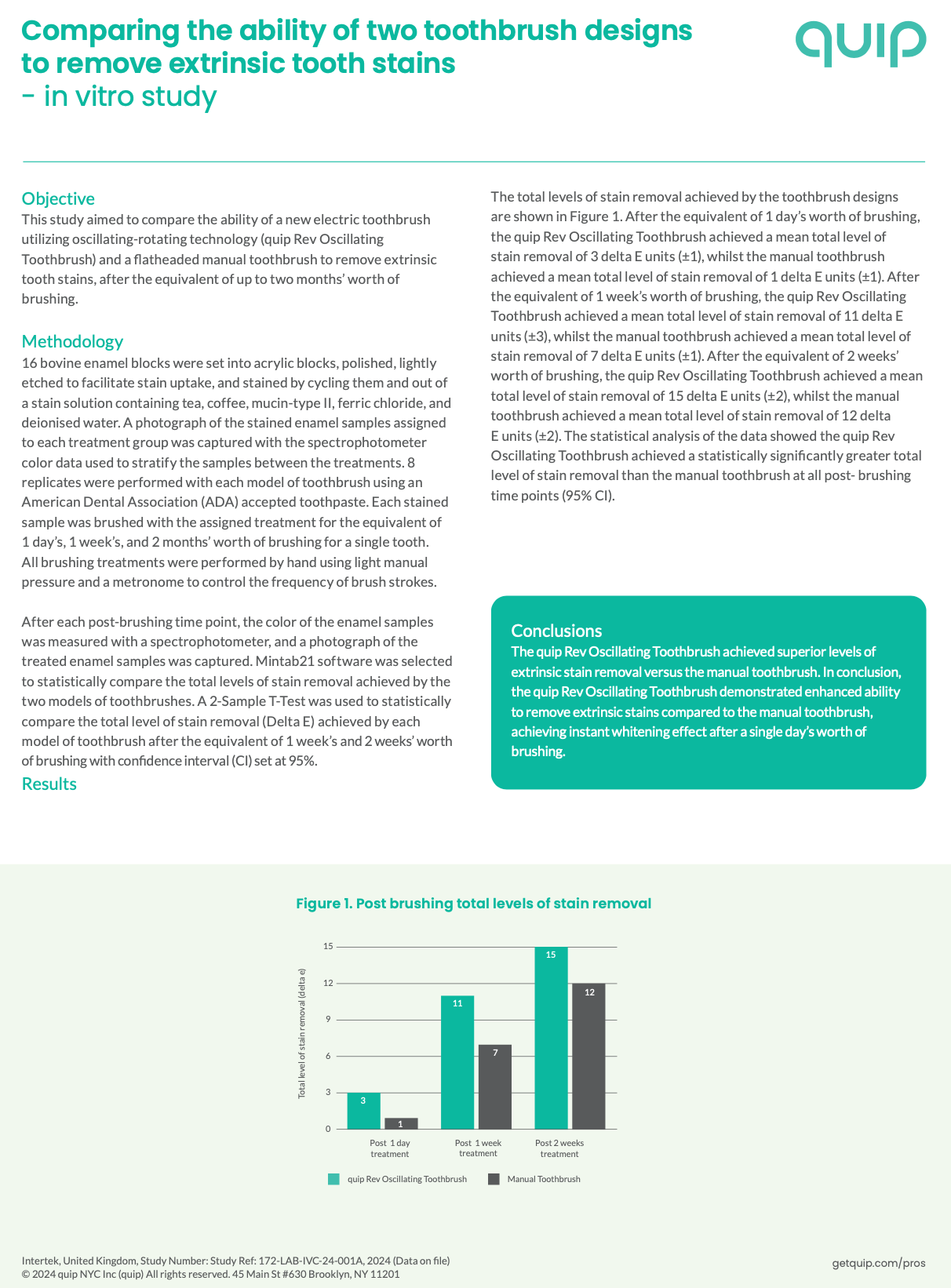Practice DAT Reading Comprehension Passage: Sponsored by quip
A big thank you to quip for sponsoring this post! Their support helps us provide high-quality, DAT-style practice materials to students preparing for success. Be sure to check out their innovative oral care solutions designed with both patients and professionals in mind.
Be sure to check out the discount link below to save 15% on your next quip purchase!
1. According to the passage, what was the main goal of the study?
A. To evaluate which toothpaste brand removed more plaque
B. To compare the stain resistance of enamel blocks
C. To assess stain removal effectiveness between two toothbrush designs
D. To measure whitening speed of commercial whitening strips
2. What type of sample was used in the experiment?
A. Human teeth embedded in resin
B. Artificial composite resin teeth
C. Bovine enamel blocks set in acrylic
D. Ceramic dental crowns
3. Which of the following best describes the brushing technique used in the study?
A. Fully automated brushing by a machine
B. Manual brushing with varying pressure
C. Manual brushing using light pressure and a metronome
D. Brushing with ultrasonic guidance
4. How was stain uptake facilitated in the enamel blocks?
A. They were artificially dyed
B. They were etched and stained using a solution
C. They were exposed to acidic foods
D. They were painted with enamel paint
5. At which time point did the manual toothbrush show the greatest increase in stain removal compared to its previous result?
A. After 1 day
B. After 1 week
C. After 2 weeks
D. No increase was observed
6. What statistical test was used to compare the toothbrushes' performance?
A. ANOVA
B. Chi-square test
C. Paired T-test
D. 2-Sample T-Test
7. Which conclusion is most supported by the results presented in the passage?
A. Both toothbrushes were equally effective after two weeks
B. Manual toothbrushes are more efficient than electric models
C. The oscillating toothbrush showed consistently higher stain removal
D. No statistically significant difference was found between toothbrushes
8. What is the significance of the ± values presented with the delta E measurements?
A. They indicate the number of enamel blocks used
B. They represent the average color change per hour
C. They show the variability or standard deviation in results
D. They reflect brushing pressure intensity
9. According to the data, what was the mean total stain removal by the manual toothbrush after 2 weeks?
A. 7 delta E units
B. 11 delta E units
C. 12 delta E units
D. 15 delta E units
10. Which of the following best summarizes the final conclusion of the study?
A. The manual toothbrush outperformed the oscillating toothbrush after extended use.
B. The oscillating toothbrush removed all stains completely.
C. The oscillating toothbrush demonstrated superior and statistically significant stain removal.
D. Neither toothbrush had any measurable effect on extrinsic stains.
✅ Answer Key with Explanations
1. What was the main goal of the study?
Answer: C. To assess stain removal effectiveness between two toothbrush designs
Explanation:
The objective stated at the beginning of the passage is “to compare the ability of a new electric toothbrush... and a flatheaded manual toothbrush to remove extrinsic tooth stains.” The goal was not about toothpaste, enamel resistance, or whitening strips.
2. What type of sample was used in the experiment?
Answer: C. Bovine enamel blocks set in acrylic
Explanation:
The methodology clearly states that 16 bovine enamel blocks were used, set into acrylic blocks to simulate teeth for stain testing.
3. What best describes the brushing technique used in the study?
Answer: C. Manual brushing using light pressure and a metronome
Explanation:
The brushing was done by hand with light manual pressure, and a metronome was used to control brushing frequency, simulating a controlled environment.
4. How was stain uptake facilitated in the enamel blocks?
Answer: B. They were etched and stained using a solution
Explanation:
Enamel blocks were “lightly etched to facilitate stain uptake,” and exposed to a staining solution made of tea, coffee, etc. This combination prepared the blocks for the stain removal test.
5. When did the manual toothbrush show the greatest increase in stain removal?
Answer: B. After 1 week
Explanation:
Stain removal rose from 1 delta E (after 1 day) to 7 delta E (after 1 week), an increase of 6 units. After 2 weeks, the change was only 5 units (from 7 to 12). So, the largest increase occurred in the first week.
6. What statistical test was used to compare results?
Answer: D. 2-Sample T-Test
Explanation:
The passage says, “A 2-Sample T-Test was used to statistically compare the total level of stain removal...” This test is appropriate for comparing means of two independent groups.
7. Which conclusion is most supported by the results?
Answer: C. The oscillating toothbrush showed consistently higher stain removal
Explanation:
At every time point—1 day, 1 week, and 2 weeks—the quip Rev Oscillating Toothbrush removed more stain than the manual toothbrush. The difference was statistically significant at all time points.
8. What is the significance of the ± values?
Answer: C. They show the variability or standard deviation in results
Explanation:
These values (e.g., “±1”) represent how much the results varied between individual samples, indicating standard deviation or spread around the mean.
9. What was the mean total stain removal by the manual toothbrush after 2 weeks?
Answer: C. 12 delta E units
Explanation:
According to the results section, after 2 weeks, the manual toothbrush achieved 12 delta E units of stain removal.
10. Which best summarizes the final conclusion of the study?
Answer: C. The oscillating toothbrush demonstrated superior and statistically significant stain removal.
Explanation:
The final paragraph concludes that the oscillating toothbrush “achieved superior levels of extrinsic stain removal” and showed an “instant whitening effect,” with statistically significant improvements.
